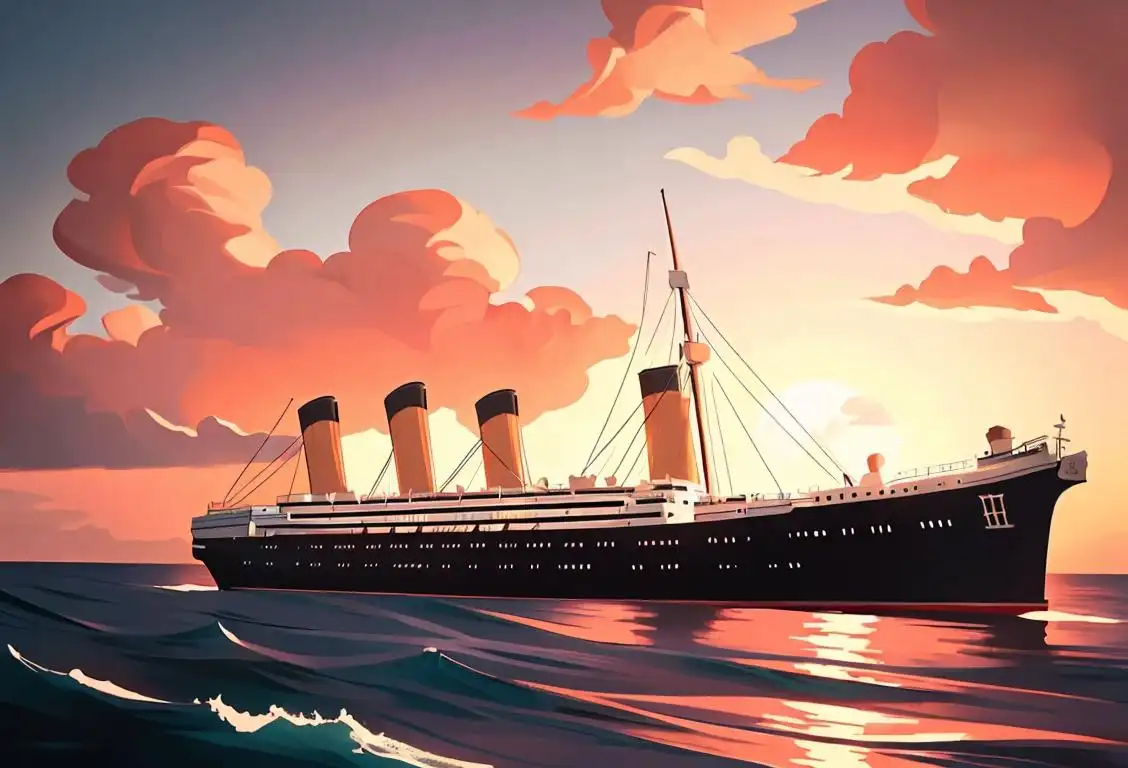National Titanic Remembrance Day

Ahoy there! Welcome to our article all about National Titanic Remembrance Day. Prepare to embark on a journey into the fascinating history of this day and discover some fun facts along the way. So grab your life jacket and let's dive in!
When is Titanic Remembrance Day?
It's national titanic remembrance day on the 15th April.
The Unsinkable Ship That Sank
On National Titanic Remembrance Day, we pay tribute to one of the most famous maritime disasters in history. Gather 'round as we voyage back to April 15, 1912, when the luxurious ocean liner, the RMS Titanic, met its tragic end.
The Titanic was meant to be unsinkable, but fate had other plans. After striking an iceberg during its maiden voyage, this magnificent vessel found itself sinking into the icy waters of the Atlantic Ocean. The event shocked the world, resulting in the loss of over 1,500 lives.
Since that fateful day, people worldwide have come together on National Titanic Remembrance Day to honor the memory of those who perished aboard this ill-fated ship. It serves as a reminder of the bravery of the passengers and crew, as well as an opportunity to reflect on the lessons learned from this tragedy.
The Internet's Love for Titanic
Did you know that the internet has a strange fascination with the Titanic? From memes to conspiracy theories, the online world has embraced the story of this legendary shipwreck. So, while we remember those who lost their lives, let's also take a moment to appreciate the curious obsession that exists on the web.
History behind the term 'Titanic Remembrance'
1912
The Tragedy at Sea
In the year 1912, the world witnessed one of the greatest maritime disasters of all time - the sinking of the RMS Titanic. The luxurious British passenger liner struck an iceberg on its maiden voyage, resulting in the loss of more than 1,500 lives. This tragic event shook the world and had a profound impact on maritime safety and international regulations.
1912
The Tragic Sinking of the Titanic
In the year 1912, one of the most famous maritime disasters occurred with the sinking of the RMS Titanic. The luxury passenger ship struck an iceberg on April 14th and sank into the depths of the Atlantic Ocean on April 15th. This catastrophic event claimed the lives of over 1,500 people, making it one of the deadliest peacetime maritime disasters in history. The tragedy of the Titanic left a profound impact on the world, sparking widespread grief and a collective need for remembrance.
1912
The Tragic Sinking
In 1912, the luxurious British ship, the Titanic, tragically sank on its maiden voyage. The ship, which was deemed unsinkable, struck an iceberg in the North Atlantic Ocean and resulted in the loss of over 1,500 lives. This devastating event became one of the most famous maritime disasters in history.
1912
Construction of RMS Titanic
In 1912, the construction of the RMS Titanic began. The Titanic was one of the largest and most luxurious passenger ships of its time, built by the Harland and Wolff shipyard in Belfast, Ireland. The construction of the Titanic was a remarkable engineering feat, reflecting the aspirations and progress of the early 20th century.
1912
Sinking of the Titanic
In 1912, the RMS Titanic, a British passenger liner, tragically sank on its maiden voyage after colliding with an iceberg in the North Atlantic Ocean. The disaster resulted in the deaths of more than 1,500 passengers and crew members, making it one of the deadliest maritime disasters in history. The sinking of the Titanic shook the world and left a lasting impact on maritime safety and travel.
1912
The Tragic Disaster
In the early hours of April 15, 1912, the RMS Titanic, considered an unsinkable ship, tragically sank on its maiden voyage after colliding with an iceberg in the North Atlantic Ocean. The disaster claimed the lives of over 1,500 people, making it one of the deadliest maritime accidents in history.
1912
The Maiden Voyage
In 1912, the RMS Titanic embarked on its maiden voyage from Southampton, England to New York City. The ship, which was considered the largest and most luxurious of its time, carried over 2,200 people on board. Little did they know, this voyage would go down in history as one of the most tragic maritime disasters.
1912
The Tragic Sinking
In 1912, the unsinkable ship, the RMS Titanic, met with a tragic fate. On April 15th, it collided with an iceberg in the North Atlantic Ocean, resulting in the death of more than 1,500 passengers and crew members. The sinking of the Titanic shocked the world and became an enduring symbol of human hubris and the consequences of overconfidence in technology.
1912
Global Mourning
Following the sinking of the Titanic, the world mourned the loss of lives and the magnitude of the tragedy. People from different countries and cultures came together to express their sorrow and pay tribute to the victims. Memorials, vigils, and remembrance services were organized across the globe, highlighting the collective grief and the need for remembrance.
1912
Global Mourning
Following the sinking of the Titanic, the world was in shock and a sense of profound grief filled the hearts of people everywhere. It was one of those devastating moments in history that transcended national boundaries, uniting people in their sorrow. The collective mourning and remembrance of the victims formed a powerful cultural response to the tragedy.
1912
Sinking of the Titanic
On April 15, 1912, tragedy struck as the RMS Titanic sank after hitting an iceberg. The ship, on its maiden voyage from Southampton to New York City, had been deemed unsinkable. The sinking of the Titanic resulted in the loss of more than 1,500 lives, making it one of the deadliest maritime disasters in history. The incident highlighted the devastating consequences of hubris and the need for improved safety measures at sea.
1912
The Disaster Strikes
On the night of April 14, 1912, the Titanic collided with an iceberg in the North Atlantic Ocean. The impact caused extensive damage to the ship's hull, leading to its eventual sinking. Despite efforts to evacuate the passengers and crew, there were not enough lifeboats, resulting in the loss of more than 1,500 lives. This catastrophic event sent shockwaves throughout the world and left an indelible mark on maritime history.
1912
The Birth of Titanic Remembrance
Following the tragic sinking of the Titanic, people around the globe mourned the loss of so many lives and sought ways to honor their memory. It was in this year, 1912, that the term 'Titanic Remembrance' began to emerge, referring to a collective remembrance and tribute to those who perished in the ill-fated voyage. Through various commemorative ceremonies, memorials, and acts of remembrance, the concept of Titanic Remembrance started to take shape, bringing people together to honor the victims and reflect on the tragedy.
1913
The Beginning of Remembrance
The year following the Titanic's sinking, 1913, marked the beginning of Titanic remembrance. People organized memorial services and vigils to honor the lives lost in the tragic event. The remembrance events aimed to pay tribute to the victims and create awareness about the need for improved safety regulations for ocean liners.
1912
Global Shock and Grief
The sinking of the Titanic sent shockwaves around the world. News of the tragedy spread rapidly, and people from all walks of life were deeply affected by the loss of life and the unimaginable horror experienced by the passengers and crew. This event prompted an outpouring of grief, mourning, and remembrance.
1912
Immediate Public Impact
After the sinking of the Titanic, the world was captivated by the news of the disaster. The sheer magnitude of the event and the loss of life shocked people across nations. Newspapers extensively covered the incident, and public sentiment quickly turned to mourning and remembrance for the victims.
1912
Titanic Remembrance Begins
In the aftermath of the Titanic disaster, communities worldwide started organizing memorial events and commemorations to honor the lives lost. These remembrance activities allowed people to come together and collectively remember the victims, paying their respects and acknowledging the sheer magnitude of the tragedy.
1985
The Wreck of the Titanic is Discovered
After more than seven decades of obscurity, the wreck of the Titanic was finally discovered in 1985 by a joint American-French expedition led by Dr. Robert Ballard. The stunning images and videos captured by remotely operated vehicles showcased the eerie remains of the ship lying at the bottom of the ocean. The rediscovery of the Titanic reignited public interest and fascination with the tragedy, further fueling the desire for Titanic Remembrance and renewing efforts to preserve the memory of those lost.
1912
Global Mourning and Commemoration
Following the sinking of the Titanic, the world was gripped by grief and shock. The scale of the tragedy led to a global outpouring of mourning and remembrance. Memorial services were held in numerous cities and towns across the world, uniting people in their grief and providing solace during a time of immense loss. The collective remembrance of the Titanic disaster became an enduring symbol of human vulnerability and the fragility of progress.
1912
Global Mourning
Following the sinking of the Titanic, the world was gripped by a collective sense of grief and loss. Newspapers around the globe covered the tragedy extensively, and people held memorial services to honor the lives lost. The event marked a turning point in maritime safety regulations and sparked a global conversation about the need for better safety measures at sea.
1912
Remembering the Titanic
As the years went by after the Titanic disaster, people continued to honor and remember the lives lost on that fateful night. The term 'Titanic Remembrance' came into existence as a way to commemorate the tragedy and pay tribute to the victims. It became a symbol of remembrance, ensuring that the memory of the Titanic and its passengers would endure in the collective consciousness of future generations.
1912
Titanic Remembrance Emerges
In the wake of the Titanic disaster, the concept of 'Titanic Remembrance' started to emerge as a way to honor the memory of those who perished. It became a way for people to reflect on the tragedy, remember the lives lost, and strive for greater safety in maritime transportation. The term 'Titanic Remembrance' encapsulated the solemn remembrance of the disaster and its victims.
1914
The Anniversary Tradition
In 1914, on the second anniversary of the Titanic's sinking, the tradition of commemorating the tragedy on its anniversary began. People observed a moment of silence and held memorial services worldwide. The anniversary became an opportunity for communities to remember and reflect upon the devastating loss.
1912
The Birth of Titanic Remembrance
In the wake of the Titanic sinking, a collective desire to remember the tragedy and honor the lives lost emerged. This led to the establishment of annual commemorations commonly known as 'Titanic Remembrance.' These remembrance events aimed to pay tribute to the victims and promote awareness about maritime safety and disaster prevention.
1985
Anniversary of the Sinking
As the years went by, the anniversary of the Titanic sinking gained significance. People started observing the anniversary as a day to remember the tragedy and its impact. The day became an opportunity to honor the victims, explore the lessons learned from the disaster, and raise awareness about maritime safety. It served as a reminder of the fragility of human endeavors and the importance of remembrance.
1912
Legacy and Cultural Impact
The term 'Titanic remembrance' refers to the ongoing tradition of honoring the memory of those who perished aboard the Titanic. It symbolizes the collective global remembrance, ensuring that the lives lost are never forgotten. Over the years, various forms of memorials, ceremonies, exhibits, artwork, books, films, and documentaries have been created, perpetuating the cultural impact of the Titanic's tragic sinking.
1953
Wartime Refocus
During World War II, the focus on Titanic remembrance dwindled as the world faced more immediate and significant challenges. Remembering the Titanic took a backseat to the wartime efforts and the countless lives lost in the conflict. However, individual enthusiasts and maritime historians continued to pay homage to the Titanic's legacy.
1912
Legacy and Annual Remembrance
In the aftermath of the Titanic sinking, the annual remembrance of the disaster started taking shape. The Titanic's tragic fate served as a catalyst for safety reforms in the maritime industry, leading to the establishment of several organizations and regulations aimed at preventing future disasters. Furthermore, the memory of the Titanic continued to resonate in popular culture through books, films, and documentaries, further solidifying its place in collective memory. The annual remembrance of the Titanic disaster serves as a reminder of our ability to learn from past tragedies and strive for a safer future.
1912
Titanic Remembrance
In the years that followed, April 15th became a day of remembrance for the Titanic disaster. People started commemorating the anniversary as a way to honor the victims and reflect upon the lessons learned from the tragedy. This act of remembrance serves as a reminder of the human cost of hubris and the importance of ensuring the safety of all those who embark on sea voyages.
2012
The Centennial Anniversary of the Titanic
In the year 2012, the world marked the centennial anniversary of the Titanic's sinking. This significant milestone served as a poignant reminder of the enduring significance of Titanic Remembrance. Numerous events and commemorations took place worldwide, including memorial services, exhibitions, special screenings of the film Titanic, and the release of new books exploring different aspects of the tragedy. The centennial anniversary not only honored the memory of the victims but also underscored the cultural impact of the Titanic and the lasting need for remembrance.
1913
First Titanic Remembrance
In 1913, just a year after the Titanic's sinking, the first official Titanic Remembrance Day was held. The day was observed on April 15, the anniversary of the ship's sinking. People gathered for memorial services, remembrance ceremonies, and wreath-laying at various locations around the world to honor the victims.
1985
The Rediscovery of the Titanic
In 1985, the wreckage of the Titanic was discovered by a joint American-French expedition led by Dr. Robert Ballard. The rediscovery reignited public interest and renewed the desire to remember and honor the Titanic's legacy. The images and videos captured by the expedition brought the tragedy back into the public consciousness.
2012
Centennial Commemoration
In 2012, the world marked the centennial of the Titanic sinking. The event sparked renewed interest in the tragedy as numerous commemorative events, exhibitions, and documentaries were organized. The centennial commemoration aimed to educate new generations about the Titanic's story, promote awareness of maritime safety, and provide a platform for collective remembrance on a global scale.
20th Century and Beyond
Continued Remembrance and Cultural Impact
Since its inception, Titanic Remembrance has continued to be observed annually. It has become an important cultural touchstone, reminding people of the human cost associated with hubris and the need for safety precautions. The sinking of the Titanic has also been immortalized in numerous books, films, and artworks that further contribute to its remembrance and cultural significance.
1997
Pop Culture Phenomenon
The release of James Cameron's blockbuster film 'Titanic' in 1997 catapulted the Titanic into popular culture. The movie depicted the ill-fated love story of Jack and Rose against the backdrop of the ship's sinking. The film's immense success further popularized the remembrance of the Titanic and introduced it to a new generation.
2012
The Centennial Anniversary
In 2012, the world marked the centennial anniversary of the Titanic's sinking. Numerous commemorative events, exhibitions, and memorial services were held worldwide to honor the lives lost and to reflect on the lessons learned from the tragedy. The centennial anniversary reaffirmed the enduring importance of Titanic remembrance.
Did you know?
Did you know that one of the Titanic survivors, Millvina Dean, lived to be 97 years old? She became the last remaining survivor before passing away in 2009. Her incredible lifespan allowed her to witness the legacy of the Titanic and its enduring impact on our culture.Tagged
awareness fun rememberanceFirst identified
15th April 2015Most mentioned on
15th April 2016Total mentions
232Other days
Voters Day
Unemployed Day
Suicide Prevention Day
Cancer Survivors Day
Memorial Day
Bestfriends Day
Heroes Day
Liberation Day
Pumpkin Day
Gymnastics Day









